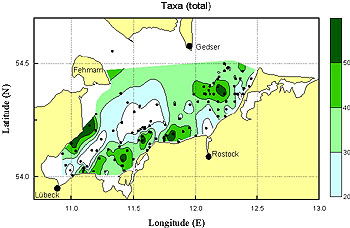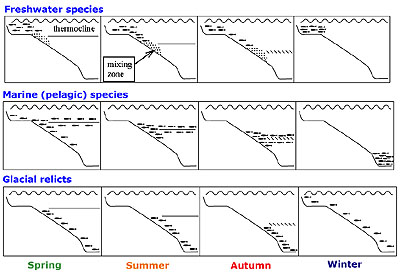Temperature and salinity, two essential structuring factors of
biodiversity in the Baltic Sea
Henn Ojaveer,
Estonian Marine Institute,
Tallinn, Estonia
Doris Schiedek,
Baltic Sea Research Institute Warnemünde,
Rostock, Germany
Table 1. Relationship between number of taxa
and salinity. At lower salinity, fewer macrobenthis species are
present.
| Area |
Macrobentic taxa |
Salinity |
| Oderhaff |
130 |
7-8 |
| Mecklenburg Bight |
c.350 |
20-10 |
| Kiel Bight |
c.500 |
25-20 |
| Kattegat |
c. 1,000 |
25-30 |
| North Sea |
c. 1,400 |
32-34 |
The Baltic Sea is a relatively enclosed brackish water body with
substantial salinity and temperature gradients. Both, the
changeable salinity conditions and the above-given gradient patterns are
the main factors influencing the distribution of the species in the
Baltic Sea. Besides these natural factors, human impact - mainly
pollution/eutrophication has been revealed as playing a significant role
in distribution and abundance of the various organisms.
The Baltic Sea is inhabited by natural immigrants of mainly three
different origin: marine boreal species (e.g. soft-shell clam Mya
arenaria, ocean quahog Arctica islandica, cod Gadus morhua
callarias, herring Clupea harengus membras, Temora longicornis,
Pseudocalanus elongatus), freshwater species (e.g., pike Esox
lucisus, perch Perca fluviatilis, Daphnia spp., Keratella
spp.) and glacial relicts (e.g., fourhorned sculpin Myoxocephalus
quadricornis, Limnocalanus macrurus, Mysis relicta).
Their preferences for the environment and, therefore, spatial
distribution differ: marine species dominate in the open Baltic and
southwestern basin, freshwater species prevail in the northeastern
Baltic and coastal areas and glacial relicts are more abundant in
communities in deeper areas of the northeastern part of the sea. Below
we give two examples how salinity and temperature affect distribution of
the Baltic biota.
Effect of the salinity gradient (Mecklenburg Bight)
In the Western Baltic Sea (Belt Sea), the transition area between the
North Sea and the Baltic Proper, high saline North Sea water mixes with
Baltic Sea water, which usually has a lower salinity due to the strong
freshwater input from the Baltic Sea catchment area. This results in a
salinity gradient (25 -10) and a pronounced halocline. Salinity as well
as oxygen content in the near bottom layer varies seasonally and between
years, depending and the saltwater inflow from the North Sea or the
river runoff. Owing to these hydrographical features this part of the
Baltic Sea forms a natural border in regard to the distribution of many
marine euryhaline organisms, as shown in Table 1 for macrobenthic
species.
 |
Fig. 1. Benthic biodiversity in the
Mecklenburg Bight (Zettler et al., 2000, and Zettler,
unpubl.).
Different studies have revealed that biodiversity in the Mecklenburg
Bight is representative for the whole southern Baltic Sea (Zettler et.
al., 2000, and unpubl. data). However, even within the Mecklenburg
Bight benthic biodiversity is not uniform, alternating between
relatively high (more than 50 taxa) and low values (less than 20 taxa)
(Fig. 1).
What are the reasons for this? As first investigations have shown,
sediment characters and oxygen availability appear to be important
factors beside salinity determining the composition of the marine
benthic communities in this area.
At present, the function of these "biodiversity islands"
for recruitment and resettlement of areas effected by oxygen depletion
or human activities (dumping, dredging) are yet not fully understood.
Effect of the seasonal thermocline (Gulf of Riga)
In spring, when water temperature starts to increase, the seasonal
themocline is formed. In the Gulf of Riga basin (max. depth ca 60 m) it
is the main factor governing the distribution of organisms due to the
lack of a halocline. The location of the thermocline moves between
spring and autumn from ca 5-10m to 25-30m water depth. In late autumn
the thermocline is less pronounced and the convective mixing in winter
results in a vertical homothermium.
 |
Fig. 2. Seasonal dynamics of the general
distribution pattern of fish of different origin in relation to the
seasonal thermocline on the coastal slope of the Gulf of Riga.
Of the three different groups of organisms, freshwater fish species
stay above the thermocline by following its seasonal course (descend to
deeper layers from spring to autumn) (Fig. 2).
The same distribution pattern is valid for most of the zooplanktonic
and benthic taxa of freshwater origin. Many of them tend to prefer warm
water. Distribution of marine eurytherm (pelagic) species is closely
connected with the temperature front. They are located around the
thermocline and in the area marked by the coastal slope and the
projection of the thermocline, called 'mixing zone'.
Except during their reproduction period in winter, glacial relicts
are confined to areas below the seasonal thermocline where the
temperature is substantially lower. However, some of them (e.g.,
smelt Osmerus eperlanus and the mysid Mysis mixta) can
also be found in the mixing zone area: they probably face shortage of
food in deeper areas (with preferred temperature conditions) and are
forced to move to warmer water in order to find sufficient amounts of
food.
Bibliography
Zettler, M.L., Bönsch, R., Gosselck, F. 2000.
Verbreitung des Makrozoobenthos in der Mecklenburger Bucht (südliche
Ostsee) - rezent und im historischen Vergleich. Meereswissenschaftliche
Berichte 42: 144pp.
|
